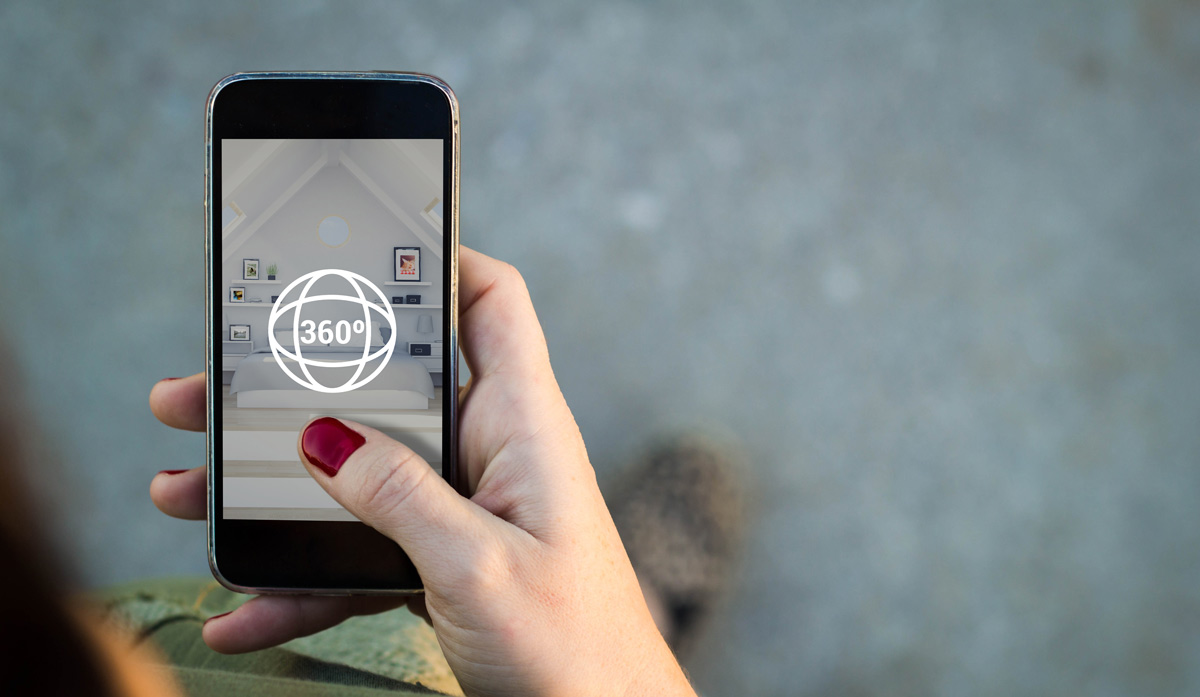Here’s a word problem for real estate agents in 2020.
John is selling the Smiths’ home to the Robertsons. Due to a novel coronavirus, the Smith family must shelter in place. If the Smiths cannot leave their house, and the state is mandating all people must keep 6 feet apart from one another at all times, how can John show an empty house to the Robertsons while maintaining the appropriate amount of distance?
John is selling the Smith’s’ home to the Robertsons, who are moving from out of state. The Smith family is able to be out of the house from 9-5pm every day. The Roberstons are only in town for 48 hours, and are only able to tour the home after 7pm either night. How can John show an empty house to the Robertsons, without inconveniencing either family?
Apologies for bringing back bad memories from algebra class. Especially because this word problem is a trick question. The answer is that John must pivot to virtual tours.
Real estate professionals are no strangers to improvisation. Perhaps you can remember a time before robust listing websites when you showed digital photos of a house to prospective buyers. Virtual tours are the next evolution in the real estate buying experience. While COVID-19 has made this evolution mandatory, the good news is that this technology has been available and attractive for years.
What is a Virtual Tour?
Tanner Hobbs, owner of Swivel Interactive, a full-service production company for real estate, defines a virtual tour as, “a clickable, interactive experience that allows buyers to walk through a home.” Virtual tours are different from static photos of a property or even video walkthroughs.
These experiences allow customers to see more angles of a home than the single perspective of a well-composed photograph, and they allow buyers to explore at their own pace, unlike a video tour. Where a video may force your perspective through the front entryway, and into the dining room, a virtual tour allows the user to stop in the entryway, look up at the ceiling, down at the floor, and back around at the inside of the door before moving on to the next room of their choice.
Now that the internet is woven into the real estate buying process, clients expect a certain level of control over the buying process. Virtual tours fulfill that desire for control, by allowing potential buyers to experience a home in their own unique way.
All truly virtual tours contain the following elements:
Viewer autonomy – Prospective buyers are able to choose when and how they view a property.
Interactivity – Viewers are able to easily explore the property, see all angles, backtrack or contemplate at their discretion.
High resolution – The quality of the tour should accurately portray the property, not covering any blemishes using lower quality images. Viewers don’t necessarily need to see individual strands of carpeting, but should have no difficulty getting a look at the bathroom fixtures.
Complete coverage – Anyone looking ought to be able to see every angle of the interior and exterior of the property.
Easily accessible – Virtual tours should be easily experienced through desktop and mobile devices and through any browser of choice.
Complete experience – A virtual tour should replicate the experience of physically viewing a home.
Virtual tours containing the above elements create an immersive experience for the user. They give potential buyers the power to view a property as many times as they deem necessary without encumbering their agent or the seller. It’s no mystery why this level of control leads to 20% of offers being made without a home visit.
The industry has not yet landed on a strict definition of what makes a “virtual tour.” For that reason, buyers’ expectations can range from an interactive 3D model to a live walkthrough led by an agent on property. Knowing the difference between all options can help a good agent plan out their best strategy as well as their budget.
3D Modeling – This type of tour involves animating the interior of a home, making the viewing experience similar to a first-person video game. 3D modeling ensures a clean interior, perfect staging, and flawless lighting. The primary drawback is that the viewer is well aware that they are looking at an idealized version, which may not be entirely accurate. The best use-case for a 3D model is for incomplete properties that are still in development. There are many companies like industry leader Matterport, making this option available to agents, brokerages, and developers.
Interactive Photo Recreations – These tours are created through the use of 360 degree cameras. Tour creators will arrive at a pre-staged property, and work their way around and through a property. Once they have taken as many as 40-50 photos (depending on the size and scope of a property), the tour creators will “stitch” the 360 degree photos together to create a fluid click-through experience similar to Google’s popular Street View. Virtual tourists will be able to see the property as it exists in reality. This is the most popular type of virtual tour, but requires a time investment to prepare the property and shoot the space. There are a number of companies, such as Omnisight or Swivel, in major metropolitan areas that can accommodate the creation of these tours.
Live Tours – With the proliferation of video chat software, most consumers have the ability to engage in a live tour led by a real estate professional. This type of virtual tour allows for the agent to guide the experience, pointing out features and benefits of the property in real time as if they were leading a traditional viewing. Agents are able to respond to viewer requests in real time while retaining a level of control over the experience. While many real estate professionals are comforted by the control granted with this type of tour, keep in mind that it requires scheduling, a strong wi-fi or data connection, use of the property, and for the property to be staged and available. On the other hand, this type of tour requires the least upfront investment in technology and equipment. Agents can choose from a variety of free and low-cost video apps like FaceTime, Zoom or Facebook Live to host this kind of tour.
The Benefits of a Virtual Tour
From the sellers to the agents and from the buyers to the neighbors who just want a peek, virtual tours benefit all parties involved in the home buying process. There are, however, benefits that remain specific to buyers and agents.
At the time of publication, buyers are worried about safety above all due to the COVID-19 pandemic. A primary benefit of a virtual tour in 2020 is that buyers are able to get an accurate feel for how a home is laid out without putting themselves at risk. But virtual tours have value even in times when it’s safe to leave the house without a mask.
- Fewer frivolous showings. Virtual tours minimize showings by weeding out low-intent buyers. If a lookie-loo can see the inside of a house from the comfort of their own couch, they don’t need to waste an agent’s time at an open house. They also help agents reclaim their weekends by reducing the amount of and length of open houses needed to sell a property.
- Increased productivity for agents. Virtual tours allow for prospective homeowners to take in a property when and where it is most convenient for them. While the benefit to consumers is obvious, the displaced nature of the experience also means that well-prepared agents can have the freedom to be in multiple locations and tours at once, expanding their reach and their closings.
- Better alignment with buyer preferences. Buyer behavior has changed. Mimicking trends in retail, prospective home buyers are overwhelmingly beginning their searches online. Not only is the internet the starting point for many buyers, but according to a Zillow Group Consumer Housing Trends study in 2018, 79% of buyers shop for homes online. Giving buyers a better online shopping experience benefits all parties involved..
- Accessibility for non-local buyers. Many buyers looking for homes in attractive markets live far enough away that showings are difficult to schedule. Virtual showings expand an agent’s reach from local markets to out-of-town and international buyers. A good tour can help a smart buyer make a well-informed purchase before their big move. A great tour can even help facilitate a sale without the buyers ever even seeing the home!
- More successful listings. 95% of buyers are more likely to call about homes with 3D virtual tours. Greater exposure means more offers, and more offers usually means a higher sale price. In an independent 2019 study, industry leader Matterport discovered that homes with a 3D virtual tour closed up to 31% faster and with a higher sales price than homes without.
Even before the government tagged real estate as an “essential business,” buyers were pushing the market toward these new technologies.
How to Make a Virtual Tour
Creating a virtual tour does not have to be a multi-day event. The trick to a good virtual tour is for agents to lean on the experience that made them such good closers in the first place.
Just like a traditional showing, virtual showings must be pre-staged (unless it’s a 3D model), the walkthrough must provide the clients with a sense of the layout, and the online experience must be easily accessible to all users.
Before attempting a virtual tour, be sure to treat the property as a good agent would before a traditional showing. This means ensuring the lawn is beautiful, removing clutter, having the carpets and walls professionally cleaned, removing all pictures and photos, and making sure that every room is neat and tidy.
Once the property has been prepped, it’s time to let it be the star. Timing the photo shoot to coincide with optimal lighting, be sure to set aside a few hours to capture plenty of quality images. Using a 360-degree camera, move from room to room, ensuring that the photos taken show off every possible angle a client might want to experience. Keep a checklist of every room completed, so that there are no reasons for time-consuming reshoots.
After capturing these massive photos, the next step is to edit them together. There are a number of low-cost options for stitching these images into a fluid virtual experience, but it shouldn’t surprise anyone that the best options available can get expensive. If the decision has been made to DIY a virtual tour, consult YouTube for tutorials on editing a virtual tour. There are a number of walkthroughs using various software, and all YouTube tutorials are free for the user.
When choosing a live broadcast of a virtual tour, be sure to schedule time with the homeowner before promising clients a specific day and time. The good news for live virtual tours is that there are a variety of free resources available across the internet. Facebook Live offers free live video on the world’s largest social media platform, with the added ability to broadcast the tour to your followers rather than just a single buyer. Similarly, FaceTime, Skype and Zoom all offer video chat solutions. These options allow buyers the ability to tell an agent what they would like to see, and where they would like the phone/camera pointed next.
Before going live it’s important to remember that vertical filming is best for face-to-face, while turning the phone horizontally is best for shooting a listing. Additionally, while phone cameras have come a long way, they are still poor at capturing in low light. Plan ahead to film during optimal lighting conditions. This will benefit both the buyer and the seller by showing off the listing when it looks its best.
If all of this is too overwhelming, investing in a partner to help capture a property may be your best course of action. Real estate focused production companies, like Swivel Interactive, Matterport or Truplace, offer photography, video, virtual tours and aerial photography to show off all sides of a home.
Some companies even offer virtual staging, which allows an agent to place digital furniture in empty rooms so that potential buyers can have a better sense of scale as they click through a listing. Virtually staging a room can run you a cost-effective $50 per room rather than the thousands invested in traditional home staging.
Outsourcing virtual tours is increasingly popular in 2020. In our interview, Hobbes estimated a 3X-4X increase in business since the beginning of March, and Redfin announced a 494% increase in requests for agent-led video home tours from the first half of March to the second half of the month. Agents need not worry about waiting in line, as these services are quickly scaling to meet demand.
Driving Attendance to Your Virtual Showing
According to Realtor Magazine, 80% of surveyed house hunters say they would “switch to a real estate agent who offers immersive 3D tours of listed properties.” Buyers’ habits and standards are changing. Images alone are no longer enough to engage a prospective home buyer. Simply having a virtual tour option will increase traffic to listings.
While having a virtual tour option certainly sets a listing apart, there are some other tried and true digital marketing practices that will ensure maximum exposure to a listing.
- Share virtual tours on social media. The spring of 2020 has seen an explosion in social media use. If an agent wants to promote a listing, go where the people already are, and the people are on Facebook, LinkedIn, YouTube, and Instagram.
- Promote a tour on real estate aggregator sites. Zillow and Trulia attract millions of visitors per day. While posting on these sites usually costs a fee, an agent should take advantage of their web traffic to boost your own presence.
- Consider social media advertising. While the federal government has rightfully placed restrictions on how targeted social ads are allowed to be, digital advertising still allows agents an unprecedented ability to place their virtual tours in front of the right people at the right time.
- Feature the virtual tour on a blog. Blogs are here to stay, and a well-managed blog with a steady stream of content can attract significant eyeballs over time. Virtual tours are a great way to provide variety to a blog that is mostly text.
- Use email marketing to stay top of mind. People socialize on Facebook, but they do business in their inboxes. The best way for a real estate professional to stay in front of their book of business is still to regularly show up in their inbox. Including a featured listing with a virtual tour should not only spice up a drip campaign, but it should also drive clicks, revealing motivated buyers.
The Time Is Now
Current market conditions have only accelerated technology and demand trends that predated the “death of the handshake.” Good agents are adopting new home showing strategies right now that will allow them greater access to a larger customer base in 2021 and beyond.



![Better Email Etiquette Equals Better Marketing Results [16 Rules]](https://www.outboundengine.com/wp-content/uploads/shutterstock_411184843-1-400x250.jpg)

